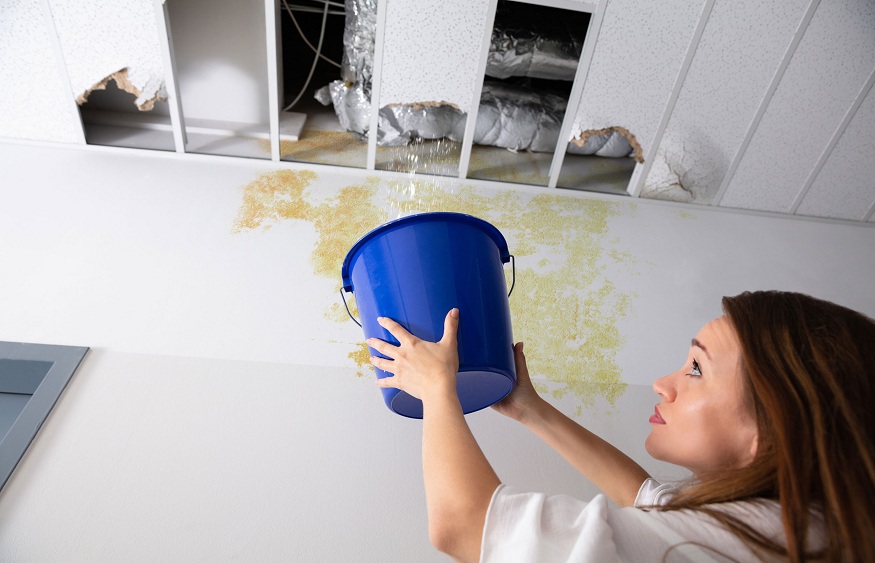So, there’s been a water leak in your bathroom? No big deal, you don’t need anyone to look at it. Just wipe away the damage and move on, right?
Wrong. Everything from plumbing leaks, sewerage or septic tanks back up all the way to large-scale flooding and natural disasters can lead to water damage. And this can impact your health if you don’t deal with it properly. You may have already known that long-term water damage can lead to structural weakness in your home, but there’s more to it than just your walls and beams getting damaged.
If you sense any unpleasant odours, it may be an indicator of mold and mildew growth, bad indoor air quality, and toxic mold growth that can create long-term health risks. This is why water damage takes more care than you might have thought, and requires steps to be taken immediately to prevent or reverse any water damage that may linger.
So what do you do if there’s water damage? What are the different types of water damage? How do you know if there is mold and what should you do? This is what we aim to explain in this guide.
Types of Water Damage
Knowing what type of water damage you have is key to understanding how to proceed with care. In general, there are three main categories of water damage that you should be aware of.
Category One: Clean Water
This is damage caused by water from rainwater, overflowing sinks, or broken pipes. If you respond to category 1 water damage within less than 48 hours, there are very few health risks. Any further exposure and the water gets exposed to contaminants which makes it move into another category, and this is where the health risks begin.
Category Two: Greywater
Greywater includes things such as chemical wastes such as detergent, soap and laundry, or equipment discharge. Water damage of Category 2 can present moderate to severe contamination risks. Greywater can encourage microbial growth, and this typically gets worse over time, leading to long-term issues.
Category Three: Blackwater
Waters from sewers or water containing oil, oil, urine, and so on are ideal instances of black water. This kind of water probably has a lot of bacteria, viruses, and other harmful allergens, which makes it contagious. Exposure to this has a high potential to cause serious illness.
Signs Your Home May Have a Mold Problem
Now that you understand which water types can cause damage, it’s time to look into the common signs that mold has taken hold in your home.
Bad Smells
If you’re experiencing a Musty-Smelling Basement, it could be indicative of water damage and potential mold growth. Water damage not only compromises the structural integrity of your home but also creates an environment conducive to mold growth. Exposure to mold spores and mycotoxins can lead to various health issues, including respiratory problems and allergic reactions.
Is there a musty, damp odor emanating from your walls or floors that reminds you of the smell of old books? Mold volatile organic compounds (MVOCs), or chemicals released during the mold life cycle, could be the source of this stench. It’s a reliable sign that there might be a mold issue in your home.
Spots on Clothing
Look for white or black spots that feel floppy or slimy to the touch on the fabric of your clothing. Check your closet first, as this can be more damper than other spaces. This might be a sign that there is a bigger mold issue inside the home.
Spots on Carpets
Carpeted areas and rugs are particularly vulnerable to becoming a mold-friendly environment in the home. On the carpet, look out for any stains, odours, or spots. Examining both sides of the carpet and padding is essential if you notice anything unusual.
Closets & Water Heater Areas
Any part of the house that is prone to moisture, like the closet for the water heater, is a good place for mold to grow. Leaks may go unnoticed because water heaters are frequently located in difficult-to-reach areas of the house. Check frequently for condensation on the floor and walls surrounding the heater to avoid a mold problem caused by a leaking water tank.
Furniture With Fungus
Mildew prefers moist leather and wood, and mold particles are more likely to remain in porous materials like foam and upholstered furniture. Check the furniture’s fibres on a regular basis for stains, fuzz, or spores.
Walls with Warping
Moisture, which gives the potential for mold, is one of the most common reasons why paint begins to bubble and wallpaper appears distorted. If your walls look warped, find where the moisture is coming from, like a nearby windowsill that is leaking, and fix it before mold grows.
Smelly A/C Filters
Does your cooling unit radiate a smelly smell in the wake of being turned on? On the filter, can you make out black, fuzzy spots? Black mold could be the cause. You may need to buy new filters or clean them more regularly.
Tiles are Tarnishing
Is there observable gunk in the grout of your washroom tiles? This is evidence of mold and mildew growth. To keep away from this issue, utilize a wiper to clear water off of the tub and walls subsequent to showering or washing. Avoid putting wet clothes and towels in the hamper, and if you notice any discolouration on the shower curtain, it needs to be cleaned as well.
If There’s Prior Water Damage
Have you ever had the unfortunate experience of discovering water damage in your home, such as flooding or burst pipes? Mold growth is likely to have occurred if the water was removed. Water damage frequently causes mold problems, which can be costly and may compromise your home’s structural integrity because fungus thrives on moisture.
What Causes Sickness from Mold?
When you breathe in toxins from mold spores, it adds to the existing toxins in your body, which is simply too much for your body to fight. For most people, the toxins get flushed out when eliminating waste, but the toxicity can get so high that the body can’t remove the waste.
No matter whether your body just is overwhelmed or can’t remove the toxins, the point is that mold can cause serious illness.
The symptoms are different for a mild case and a more significant case, so here’s the difference.
Regular exposure to mold causes:
- Rashes
- Watery eyes
- Runny noses
- Itchy eyes
- Redness of the eyes
- Long lasting sinusitis
- Allergy flares
- Persistent cold symptoms
More serious symptoms include:
- Joint pain
- Muscle cramps and aches or pains
- Headaches and migraines
- Numbness, or tremors, tingling in extremities
- Dizziness or vertigo
- Fatigue and weakness
- Poor memory ability.
- Brain fog or difficulty focusing
- Respiratory illnesses or infections
How Do You Get Rid of The Mold?
So now you know that you definitely have mold, and maybe it’s the cause of your illness. What now? The key point is mold recurs, so you need to find out why mold is happening and remove the reason.
Ventilate Your Home
Ensure that wet rooms are vented to the outside air. This implies ensuring your exhaust fans are ducted (associated with) outside the rooftop space. Unless the cavity in the ceiling is ventilated, don’t dump the moisture there.
Insulate the Area
If your bathroom’s walls and ceiling are insulated, it may not be cold enough for water to condense on their surfaces, and this reduces mold or removes it entirely.
Double Glazed Windows
As they don’t get as cold as single glazing, double-glazed windows are much less likely to have water vapor condense on them. Simply ensure that the window frames have insulated correctly This stops heat energy from being transferred between your home and the outside (as opposed to a purely metal frame).
Treat Mold Fast
You can clean bleach off at home, by using diluted vinegar, bleach or mold killers with a microfibre cloth. It’s important to know however that vinegar is a food source for some molds and bleach can often clean the color of the mold but not remove it. Be aware, a mold problem is always a moisture problem, so removing mold is only temporary until the moisture problem is fixed.
Safety Matters
Mold is ultimately dangerous so remember to wear long pants, long sleeves, rubber boots and gloves, goggles and a respirator mask before you try to DIY mold removal.
Head To A Doctor
If you think your illness may be mold caused, heading to a doctor is also vital to start treatment before you fix the issue in your home.
Too Much For You To Handle?
Mold and any water damage in general isn’t easy to handle alone. Not only do you have to manage the cause of the water damage, you must also handle the cleaning, testing, mold removal and stopping the issue from happening again. This can be time-consuming and costly if you don’t have the necessary equipment on hand immediately.
So if you just want to skip to the problem being solved? Consider Flood Pro’s USA, a 24 hour emergency service for water, fire, smoke and mold related issues.
If you’re in the Marietta area, contact them for your mold issues now.




